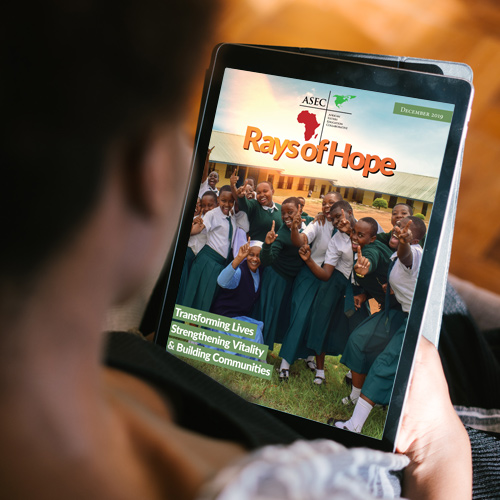In 2015, Pope Francis made an apostolic journey to Kenya, Uganda and the Central African Republic. During this journey, Pope Francis addressed clergy, men and women religious and seminarians and reminded them that
“when we let ourselves be chosen by Jesus, it is to serve: to serve the people of God, to serve the poor, men and women who are outcasts, living on the fringes of society, to serve children and the elderly...Letting ourselves be chosen by Jesus means letting ourselves be chosen to serve, and not to be served.”
The Philosophy of Servant Leadership
It is no coincidence that ASEC’s first and longest running program, the Sisters Leadership Development Initiative (SLDI), was built on a foundation of servant leadership concepts and ideals. Servant leadership is a philosophy, first proposed by Robert Greenleaf in 1970, that values social responsibility and the support of others’ growth and well-being above all else.5 This philosophy stems from Christian religious teachings, having been traced by researchers to Jesus’ demonstrations and instructions to his disciples.7
From an African perspective, servant leadership has been found to be positively correlated with leader effectiveness.1 Some suggest this is due to the parallelism between servant leadership and African philosophies such as Ubuntu meaning “I am because we are” and harambee, which is Swahili for “all pull together”.8
Servant Leadership Characteristics
Specific servant leadership characteristics vary greatly within academic literature. Perhaps this variation is related to Greenleaf’s assertion that servant leaders cannot be defined by what they do, but rather who they are.2 Nevertheless, Eva, Robin, Sendjaya, Dierendonck and Liden suggest that servant leadership can be measured by assessing individuals on eight dimensions: standing back, forgiveness, courage, empowerment, accountability, authenticity, humility and stewardship.3
The Impact of Post-Secondary Education on Servant Leadership for African Sisters in Kenya
In my dissertation entitled “Perspectives of Post-Secondary Education in Kenyan Religious Life: A Case Study,” I aimed to determine if participation in a post-secondary education program transforms Kenyan sisters’ understanding of their lives as women religious and if participation influences how they view themselves in ministry (N = 17).6 I discovered that participation in a post-secondary education program can contribute to the development of women religious as servant leaders.
Through the achievement of post-secondary education, sisters
- enhance their ministerial abilities
- gain empowerment and
- are better enabled to relationally engage with others.
These outcomes align with servant leadership characteristics, allowing women religious to fulfill their roles with integrity and permitting them to serve those in need with precise skill and care. In conclusion, I propose that post-secondary education programs provide sisters in Africa an opportunity to develop into influential servant leaders, who are more capable of carrying out their mission to spread God’s love through service.
Servant Leadership and the Higher Education for Sisters in Africa (HESA) program
The findings of my dissertation are particularly relevant for ASEC’s Higher Education for Sisters in Africa (HESA) program. My study suggests that HESA sisters, studying across the African continent, have the potential to develop as servant leaders, who can make lasting positive change in their communities and can encourage the achievement of world-wide gender equality.
Given these insights, it is especially important that the long-term impacts of the HESA program continue to be evaluated, monitored and shared. It is clear that the future is bright for HESA sisters and we are only beginning to see the wide-spread positive change they will bring to the people they serve.

Read Rays of Hope
Learn more about Catholic Sisters transforming poor, rural communities across Africa in our FREE Rays of Hope ebook.
Read It Now »References
- Brubaker, T. A. (2013). Servant leadership, ubuntu, and leader effectiveness in Rwanda. Emerging Leadership Journeys, 6(1), 114-147. Retrieved from https://www.regent.edu/acad/global/publications/elj/vol6iss1/elj-vol6iss1.pdf#page=105
- Dierendonck, D. V. (2010). Servant leadership: A review and synthesis. Journal of Management, 37(4), 1228-1261. doi:10.1177/0149206310380462
- Eva, N., Robin, M., Sendjaya, S., Dierendonck, D. V., & Liden, R. C. (2019). Servant leadership: A systematic review and call for future research. The Leadership Quarterly, 30(1), 111-132. doi:10.1016/j.leaqua.2018.07.004
- Francis. (2015, November 26). Meeting with clergy, men and women religious and seminarians address of his holiness Pope Francis. Retrieved July 25, 2019 from https://m.vatican.va/content/francesco/en/speeches/2015/november/documents/papa-francesco_20151126_kenya-religiosi.html
- Greenleaf, R. K. (1970). The servant as a leader. Cambridge, MA: Center for Applied Studies.
- Lopatofsky, T. (2019, March). The perceived impact of a post-secondary education program on Kenyan Catholic sisters’ understanding of their lives as women religious: A case study (Doctoral dissertation, Marywood University).
- Paris, D.L., & Peachey, J.W. (2013). A systematic literature review of servant leadership theory in organizational contexts. Journal of Business Ethics, 113(3), 377-393. doi: 10.1007/s1055101213226
- Winston, B. E., & Ryan, B. (2008). Servant leadership as a humane orientation: Using the GLOBE study construct of humane orientation to show that servant leadership is more global than western. International Journal of Research Studies, 3(2), 212-222. Retrieved from https://www.regent.edu/acad/global/publications/ijls/new/ vol3iss2/IJLS_V3Is2_Winston_Ryan.pdf





